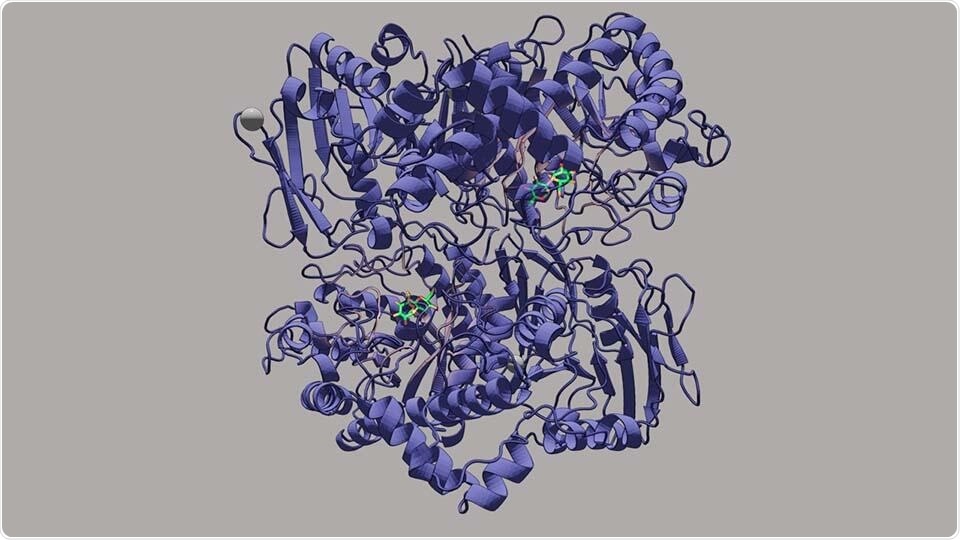The accurate mechanism of action of a β-1,2-glucan-associated enzyme has been determined by Japanese researchers, providing new insights into intricate sugar metabolism.

Tokyo University of Science researchers in collaboration with Niigata University researchers have unraveled the mechanism of action of IaSGT—a novel enzyme that catalyzes the synthesis of glycosidic covalent bonds in carbohydrate chains. Image Credit: Masahiro Nakajima from Tokyo University of Science
Many organic molecules in glycosides are given functionality by sugar chains. In several biological systems, enzymes such as glycosyltransferases catalyze the production of these chains. Commercial manufacturing of carbohydrate chains employing enzymes related with β-1,2-glucan, a polysaccharide, however, poses technical difficulties.
Scientists from Tokyo University of Science and Niigata University have now identified a novel enzyme that catalyzes the easy creation of glycosidic linkages in β-1,2-glucooligosaccharide glycosides on a functional and structural level.
Carbohydrate chains have an important role in the human body. Carbohydrate chains, for example, are connected to numerous biologically important proteins and lipids in human bodies. These “sugar” chains, indeed, serve an important role in modifying the functionalities of organic molecules such as aromatic compounds, to which they are frequently connected. It is well known that the activities of substances linked to these carbohydrate structures can be altered by them.
Biochemical activities involving enzymes such as glycosyltransferases accelerate the biological production of these chains. Commercial manufacture of carbohydrate chains, on the other hand, faces several technical obstacles.
The structure and activity of a novel glycosyltransferase enzyme have now been determined by a group of researchers from Tokyo University of Science and Niigata University who collaborated together.
The findings of this study were published in the Journal of Biological Chemistry and made available online on January 19th, 2022.
The structures and functions of enzymes that synthesize and degrade carbohydrate chains have become extensively diversified through molecular evolution. To date, various kinds of enzymes related to carbohydrates have been found and added to the Carbohydrate-Active enZYmes or CAZy database.”
Dr Masahiro Nakajima, Study Senior Author and Associate Professor, Tokyo University of Science
“This database classifies these enzymes, called CAZymes, into families mainly based on their amino acid sequences and is now expanding. However, obtaining carbohydrates is often difficult because of their rarity or inhomogeneity in nature, which limits the exploration of novel enzymes,” Dr Nakajima added.
The β-1,2-glucan polysaccharide is a homopolymer made up of β-1,2-linked glucose molecules. Using any of the existing experimental procedures, this carbohydrate cannot be easily achieved in commercially feasible amounts from natural resources.
Despite the fact that β-1,2-glucans are implicated in bacterial infection, hypo-osmotic adaptation, and iron storage, their precise mode of action is unknown, owing to their scarcity. This lack of availability is due to a scarcity of research on the enzymes involved in β-1,2-glucan metabolism.
In the metabolism of β-1,2-glucan, the enzyme endo-β-1,2-glucanase is included. The biochemical activity of a new β-1,2-glucan-associated enzyme was discovered using advanced structural identification and biochemical characterization approaches, including mutagenesis and reaction rate estimation.
We have discovered an enzyme that performs a novel chemical reaction. Our newly discovered mechanism of action has paved the way for the synthesis of sugar chains that were incredibly difficult to synthesize.”
Dr Masahiro Nakajima, Study Senior Author and Associate Professor, Tokyo University of Science
“Although several glycans are involved in biologically important roles, there are many whose functions cannot be fully understood owing to low reaction yields. We believe that this discovery has expanded the possibilities for the successful development and use of sugar chains,” Dr Nakajima added.
The IALB 1185 protein (IaSGT) is a “glycoside hydrolase” family 35 (GH35) protein that is produced in the gene cluster that codes for endo-β-1,2-glucanase homologs. In contrast to predictions, the researchers discovered that IaSGT is a “glycosyltransferase” that acts on β-1,2-glucosidic bonds.
This was a new catalytic activity that the protein displayed. Glycosyltransferases catalyze the production of glycosidic bonds, whereas glycoside hydrolases catalyze the destruction or hydrolysis of glycosidic bonds, a chemical reaction involving water.
Based on these results, the researchers recommend the systematic name “β-1,2-glucooligosaccharide:D-glucoside β-D-glucosyltransferase” and the approved name “β-1,2-glucosyltransferase” for IALB_1185.
Glycosyltransfer reactions are useful for oligosaccharide synthesis, but glycosyltransferases in glycoside hydrolase families share their reaction mechanisms with glycoside hydrolases. Therefore, we need a complete comprehension of their reaction mechanism to control conversion between transferases and hydrolases freely.”
Dr Hiroyuki Nakai, Study Lead Collaborator and Associate Professor, Niigata University
“Our findings are important biochemical data for understanding the diversity of CAZymes and a fundamental structural basis for further investigation of the profound enigma of the reaction mechanisms of CAZymes,” Dr Nakai added.
The scientific community is optimistic that the recently discovered and functionally defined enzyme will speed up the production of carbohydrate chains, which are important in a variety of biological activities.
Source:
Journal reference:
Kobayashi, K., et al. (2022) Characterization and structural analyses of a novel glycosyltransferase acting on the β-1,2-glucosidic linkages. Journal of Biological Chemistry. doi.org/10.1016/j.jbc.2022.101606.